The Enduring Boatswain's Pipe
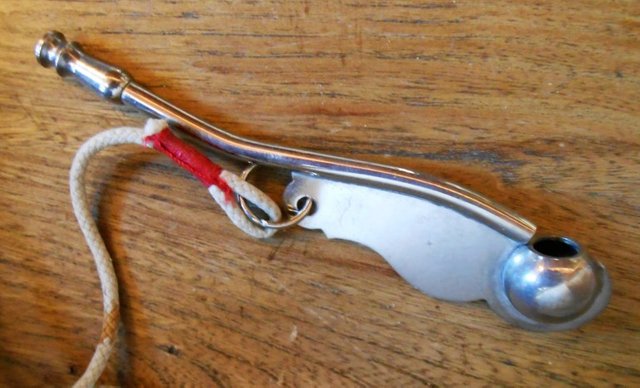
Vintage pipe with attached lanyard
In my rambunctious childhood years, ‘Pipe Down!’ was a command I heard all too frequently from my parents. It wasn’t until recently that I discovered that the phrase had ancient nautical roots. It is one of several orders that the ‘boatswain’ (pronounced and often written as ‘bosun’) conveys to a naval crew by means of a small metal whistle. The bosun, in past centuries, was the officer in charge of rigging and sails. His pipe could be counted on to penetrate the noisiest conditions far better than the human voice. In times of war or howling gales, the pipe was a critical instrument of communication.
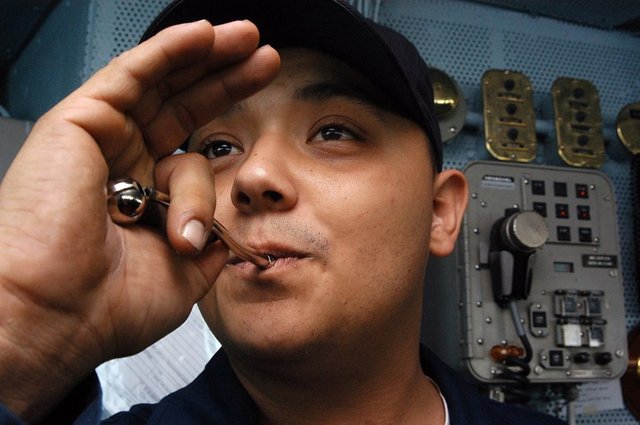
040504-N-6278K-076 Arabian Gulf (May 4, 2004) - Boatswain's Mate 3rd Class Rene Reyna, of Donna, Texas, pipes sweepers over the 1MC intercom on the bridge aboard USS George Washington (CVN 73). The Norfolk, Va.-based aircraft carrier is on a scheduled deployment in support of Operation Iraqi Freedom (OIF). U.S. Navy photo by Photographer's Mate Airman Joan Kretschmer. (RELEASED)
Boatswain’s Mate 3rd Class Rene Reyna, of Donna, Texas, pipes sweepers over the 1MC intercom on the bridge aboard USS George Washington (CVN 73). U.S. Navy photo by Photographer’s Mate Airman Joan Kretschmer. (RELEASED)
Today, of course, loudspeaker systems and radios have largely replaced the ‘pipe’ for communications but for many navies around the world, steeped in tradition, the bosun’s call is still an integral piece of equipment. Nowadays, the pipe is mainly used as a mark of respect to pipe the Captain or special visitors on board, or for emphasizing important orders.
Variously called the bosun’s pipe, whistle, or ‘call’, this shiny nautical item has saved many a life and ship over the many centuries it has been in use. A version of the whistle has been around since Greek and Roman times where it might have regulated the beat of the slave’s oars. By the 16th century, the pipe had become an established badge of office and honor in England’s navy.
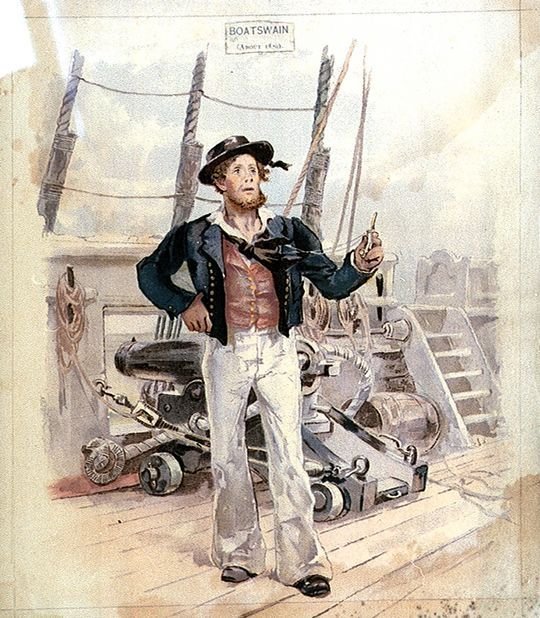
Royal_Navy_Boatswain_1820 source pinterest
The standard modern pipe measures about 5 inches (12.7 cm) long and is usually attached to a lanyard that is pinned to a jacket pocket or worn around the neck. It is commonly made of nickel-plated brass, steel, or sterling silver. A narrow tube (the ‘gun’) directs air over a small metal ball (the ‘buoy’) that has a hole on top (the ‘pea’).
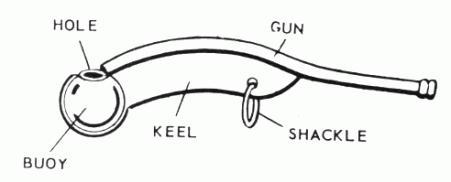
One holds the pipe by gripping the ‘keel’ below the ‘gun’ with the thumb and forefinger. The remaining fingers are cupped above the ‘buoy.’ By flexing the fingers over the ball, the pitch is changed and simple melodies can be played. In the hands of an experienced piper, whole tunes can be played.
There are dozens of commands and a competent boatswain must learn them all and pipe them to perfection. It seems simple enough: blow into the pipe and if it’s well-tuned, it will produce a clean high-pitched whistle. But the boatswain must learn how to make it warble, chirp, and trill, as well. Warbling and trilling are accomplished by moving the tongue inside the mouth as one blows on the call. Commands are often complicated combinations of trills, peeps, and blasts.

A complicated series that every hungry sailor knows! (Courtesy: Gillingham Sea Scouts)
‘Piping the side’ (or ‘Piping aboard’) is an especially important command as it is a signal of respect for the coming aboard of such VIP’s as sovereigns, high-ranking naval personnel, or even corpses. This call starts with a long low note, followed by a high note, then a low note.
You can buy bosun’s pipes readily enough in maritime shops or on-line. ‘Acme’ makes a good playable pipe; don’t plan on making any usable sounds on the cheap brass ones that come in wooden presentation boxes. Older pipes that have some history or that are made of sterling silver are very collectible.
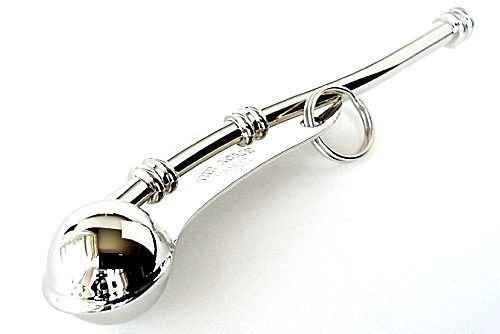
The bosun’s pipe has been an enduring part of maritime operations for centuries. Will its importance continue? If ‘Star Trek’ is any harbinger of the future, it most certainly will! There are several episodes where a futuristic electronic version is used to pipe honorary guests aboard or at a crewmember’s funeral as the body is released into space.
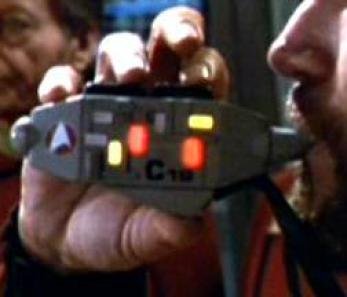
Electronic_Boatswains_whistle, courtesy Star Trek
By the way, the ‘Pipe Down’ command means ‘Dismissal of all the crew not actually on a watch’ or ‘Lights out, all hands turn in’ (which I think was what my parents were telling me to do!).

courtesy of Gillingham Sea Scouts
This post has received a 9.90 % upvote from @sleeplesswhale thanks to: @cavesson.
This post has received a 3.19% UpGoat from @shares. Send at least 0.1 SBD to @shares with a post link in the memo field.
To support our daily curation initiative, please donate 1 SBD or delegate Steem Power (SP) to @shares by clicking one fo the following links: 10 SP, 50 SP, 100 SP, 500 SP, 1000 SP, 5000 SP.
Support my owner. Please vote @Yehey as Witness - simply click and vote.
Wow greate article!
You just got a 10.19% upvote from @postdoctor!
Thanks for using the @postdoctor service!